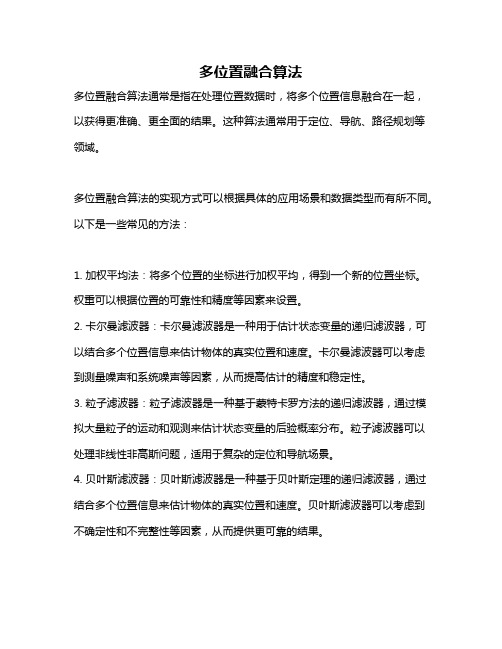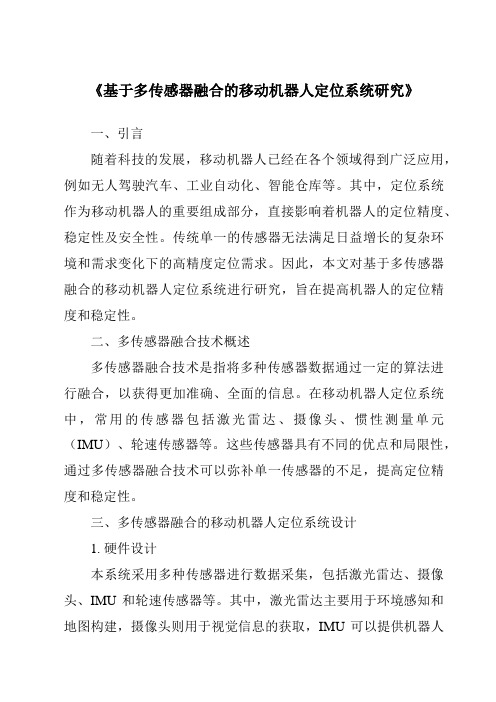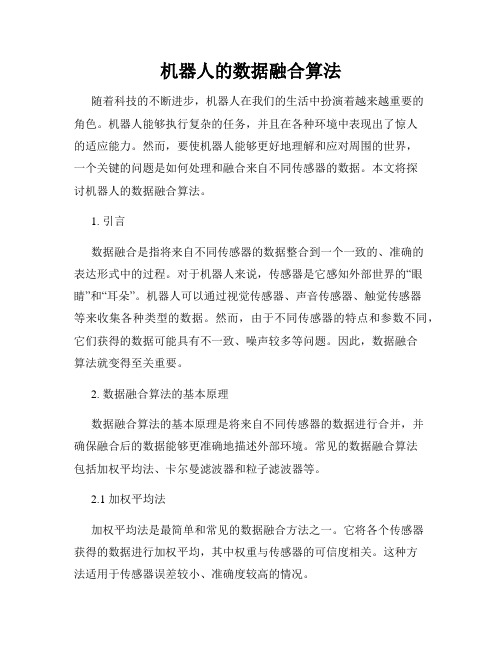多机器人系统中的目标定位数据融合方法 ICRA01
基于GPS的移动机器人多传感器定位信息融合

第22卷 第6期2006年12月天 津 理 工 大 学 学 报JO URNAL O F T I ANJ I N UN I VERS I TY O F TECHNOLO G YVol.22No.6Dec.2006文章编号:16732095X(2006)0620047203基于GPS的移动机器人多传感器定位信息融合孟祥荔,曹作良(天津理工大学机械工程学院,天津300191)摘 要:构建了基于GPS的移动机器人定位系统,利用多传感器数据自适应加权融合估计算法对GPS、方位传感器、光码盘的信息进行数据融合.通过实验证明,该系统在短距离、路面平整的条件下,具有较高的准确性和稳定性,能够满足移动机器人定位的需要.关键词:GPS;移动机器人;数据融合中图分类号:TP242.2 文献标识码:AM ulti2sen sor loca li za ti on i n for ma ti on fusi on form ob ile robot ba sed on GPSM ENG Xiang2li,CAO Zuo2liang(School ofM echanical Engineering,Tianjin University of Technol ogy,Tianjin300191,China)Abstract:The l ocalizati on syste m f ormobile r obot based on GPS is p r oposed.GPS data,azi m uth sens or data and op tical en2 coder data are fused using the adap tive weighted fusi on esti m ated algorith m of multi2sens or data.The experi m ent result indi2 cates that the system can achieve better veracity and stability,under the p reconditi on of the short distance and s mooth sur2 face.The p r oposed syste m can reach the require ment for the l ocalizati on of mobile r obot.Key words:GPS;mobile r obot;data fusi on 移动机器人是一种在复杂环境中工作的具有自规划、自组织、自适应能力的机器人[1].在移动导航中,GPS接收机定位精度通常受到卫星信号状况和道路环境的影响,同时还受到诸如时钟误差、传播误差、接收机噪声等诸多因素的影响[2].提高系统定位精度有很多途径,例如:利用GPS结合电子地图;利用GPS信号对野外环境中的机器人进行粗定位,然后利用全景图像数据精确定位;用多传感器数据融合算法融合GPS定位数据和其他数据信息组成定位系统.基于GPS的移动机器人定位系统由GPS、方位传感器、光码盘组成,采用多传感器信息融合技术,利用绝对定位和相对定位相结合的方法,实现移动机器人定位.多传感器数据自适应加权融合估计算法不要求知道传感器测量数据的任何先验知识,计算量不大,满足移动机器人实时性的要求.实验表明,在短距离、道路平坦的前提下,能够满足移动机器人定位的需要.1 系统构建首先利用光码盘得到的数据通过航迹推算法得到移动机器人的车体位置,然后与GPS、方位传感器图1 系统构成F i g.1 The syste m structure收稿日期:2006206226.基金项目:天津市自然科学基金(023615011).第一作者:孟祥荔(1981— )女,硕士研究生.得到的数据信息通过多传感器数据自适应加权融合估计算法进行数据融合,从而得到最终的移动机器人的车体位置.1.1 GPS系统GPS的工作原理:GPS接收机接收到卫星发出的伪距信号然后进行解码,通过计算得出在地球上的绝对位置.本GPS系统的用户设备由北斗天璇GPS接收器、CSI差分信标机和GPS天线组成.GPS 数据遵循NMEA-0183协议,本系统利用定位语句GPGG A中的数据信息.例如:$GPGG A,072027. 00,3905.1026,N,11708.6237,E,1,04,9.9,-19. 4,M,-3.1,M,363其中:072030.00———UTC_TI M E24h(24h)制的标准时间.表示:UTC时间07:20:30.00.3905.1027,N———纬度.表示:北纬39°05. 1027′.11708.6257,E———经度.表示:东经117°08. 6257′.1———表示定位质量,0=未定位,1=无差分定位,2=差分定位.04———表示定位所用的卫星数目.9.9———表示水平精度因子.-19.4,M———表示从平均海水面算起的海拔高度,单位是米.-3.1,M———表示大地水准面差距,单位是米.空字段1———表示DGPS的数据期龄,单位是秒,当不使用DGPS时是空.空字段2———表示DGPS基准站编号,当不使用DGPS时是空.363———校验和.GPS接收机收到的定位信号是在GPS-84坐标系下的.在移动机器人定位中,需要把坐标系统转化为空间直角坐标系统.转换关系式为:设:L、B、H 分别表示目标点的经度、纬度和大地高度;X、Y、Z分别表示目标点在空间直角坐标系下的位置坐标.X=(N+H)cos B cos LY=(N+H)cos B sin LZ=[N(1-e2)+H]sin B(1)其中:N表示目标点的卯酉圈曲率半径,N= a1-e2sin2Ba表示椭球的长半轴,a=6378137mf表示椭球扁率,f=0.003352810664747e表示第一偏心率,e2=2f-f21.2 方位传感器和光码盘方位传感器是以北方位基准方向,测量机器人的朝向与基准方向的偏角.计算公式为:设θ表示对应角度;T表示对应的实际计数时间;Y表示P WM波的脉宽.T=(Y×128)/30000θ=(T-1)×10本系统采用的方位传感器芯片是Devantech公司的C MPS01;工作电压5V,额定电流15mA.光码盘的工作原理是:将光码盘装在机器人的左右驱动轮上,当两轮走过一段距离时,通过光码盘就可以得到距离信号,然后通过换算就可以得到两轮行走的距离.2 多传感器信息融合多传感器信息融合是协调利用多个传感器,通过对各传感器获得的未知环境特征信息的分析和综合,得到对环境全面、正确的估计,它避免了单一传感器的局限性,可以获取更多信息,得出更为准确、可靠的结论[3].对于本定位系统首先通过GPS接收机接收到移动机器人的初始位置信息,然后利用光码盘信息采用航迹推算法得到当前机器人的位置(Xg,Y g)及方向角θg.GPS接收机接收到的GPS定位信号,利用公式(1)进行坐标变换,得到较为准确的机器人位置坐标(Xh,Y h).利用方位传感器信息经过公式计算得出方向角θh.采用多传感器数据自适应加权融合估计算法分别对Xg和Xh、Yg和Yh、θg和θh进行数据融合得到车体的最终位置.多传感器自适应加权融合估计算法的思想是:在总均方误差最小这一最优条件下,根据各个传感器所得到测量之以子适应的方式寻找各个传感器所对应的最优加权因子,使融合后的数值达到最优[4].设:由GPS接收机得到的测量值为Xg,由航迹推算法得到数据为Xh.X g的自协方差函数R gg的时间域估算值为R gg(k),Xh的自协方差函数Rhh的时间域估算值为Rhh (k),Xg和Xh的互协方差函数Rgh的时间域估算值为Rgh(k).其中k为数据个数.R gg(k)=k-1kR gg(k-1)+1kX g(k)X g(K)・84・ 天 津 理 工 大 学 学 报 第22卷 第6期R hh (k )=k -1k R hh (k -1)+1k X h (k )X h (K )R gh (k )=k -1k R gh (k -1)+1kX g (k )X h (K )对于GPS 接收机的方差,σ2g =R gg -R gh对于航迹推算法得到的数据方差,σ2h =R hh -R gh 则GPS 接收机数据对应的加权因子为:W g =σ2hσ2g +σ2h 航迹推算法得到的数据对应的加权因子为:W h =σ2gσ2g +σ2h 所以:此刻估计值^X =W g X g +W h X h对于,Y g 和Y h 、θg 和θh 的数据融合后估计值的计算同上.3 实验结果在室外开阔平整场地,建立相互垂直的两直线,分别找到等间距的14个点,相邻两点相距1m.为了便于对比,分别给出各点的实际位置(如图1所示),GPS 的数据信息(如图2所示),数据融合后的数据信息(如图3所示).图2 各点的实际位置F i g .2 The rea l positi on of each po i nt图3 GPS 的数据信息F i g .3 GPS da t a i n forma tion图4 数据融合后的信息F i g .4 Da t a i n for ma ti on after da t a fusi on从以上结果可以看出:在短距离、路面平整的情况下,GPS 数据不会出现较大偏差,但是数据的定位离散性较大;而且受到卫星状况的影响,差分信号的接收出现不稳定.利用航迹推算法得到的数据信息连续性好,有累积误差,但是在短程定位有很大优势.本定位系统采用了比较简单的多传感器自适应加权融合估计算法,在数据融合后,综合了各个传感器的优点,减小了GPS 数据信息离散性的影响,消除了航迹推算法产生的累积误差,从而提高了系统的定位精度.4 结 论基于GPS 的移动机器人定位导航系统采用多传感器融合技术提高了系统的定位精度和可靠性.利用航迹推算法,首先需要移动机器人的初始位置,GPS 能够给出相对准确的初始位置坐标.采用多传感器数据自适应加权融合估计算法,融合GPS 信息和光码盘、方位传感器信息,并且在GPS 信号受到影响时,利用航迹推算完成移动机器人的定位.该定位导航系统适合于移动机器人在短距离、路面平坦、环境空旷的情况.如果采用定位精度更高的GPS 系统,并对GPS 明显异常数据进行处理,采用更为复杂的多传感器数据融合算法,可以更好的提高移动机器人系统的定位精度.参 考 文 献:[1] 郑向阳,熊 蓉,顾大强.移动机器人导航和定位技术[J ].机电工程,2003,20(5):35237.[2] 欧阳正柱,何克忠.GPS 在智能移动机器人中的应用[J ].微计算机信息,2001,17(11):56258.[3] 范新南,苏丽媛,郭建甲.多传感器信息融合综述[J ].河海大学常州分校学报,2005,19(1):124.[4] 翟翌立,戴逸松.多传感器数据自适应加权融合估计算法的研究[J ].计量学报,1998,19(1):69275.・94・2006年12月 孟祥荔,等:基于GPS 的移动机器人多传感器定位信息融合。
一种基于多机器人的位置融合感知方法和系统[发明专利]
![一种基于多机器人的位置融合感知方法和系统[发明专利]](https://img.taocdn.com/s3/m/4ec7fed287c24028905fc32f.png)
专利名称:一种基于多机器人的位置融合感知方法和系统专利类型:发明专利
发明人:秦豪,赵明
申请号:CN202011570409.9
申请日:20201226
公开号:CN112720490A
公开日:
20210430
专利内容由知识产权出版社提供
摘要:本发明公开了一种基于多机器人的位置融合感知方法和系统,多机器人包括目标机器人A和处于同一场景的N个机器人B,方法包括以下步骤:每个机器人B分别获取目标机器人A与自身的相对位置,并根据当前自身定位以及所述相对位置计算目标机器人A在本视角下的相对绝对位置;目标机器人A接收所有机器人B发送的相对绝对位置,并根据相对绝对位置对当前自身定位进行更新。
本发明通过视觉识别融合激光数据的方法,并根据机器人群体的绝对定位及置信度,对机器人群体的定位进行更新,使机器人群体在业务场景中像一张网,增加了多机器人之间的交互、语义感知能力,还能进一步强化多机器人群体在复杂环境中的定位稳定性。
申请人:上海有个机器人有限公司
地址:200120 上海市浦东新区南汇新城镇环湖西二路888号
国籍:CN
代理机构:北京天盾知识产权代理有限公司
代理人:梁秀秀
更多信息请下载全文后查看。
机器人多源信息融合定位算法研究

机器人多源信息融合定位算法研究引言:随着科技的不断发展,机器人已经渐渐走进我们的生活。
然而,要使机器人能够准确地定位自身在空间中的位置,却是一个相当复杂的问题。
传统的单一传感器定位方法在很多情况下并不可靠,因此,研究者们开始探索多源信息融合定位算法,以提高机器人定位的准确度和鲁棒性。
多源信息融合定位的意义:在机器人定位中,准确精准的定位是保证机器人能够正确完成任务的基础。
而多源信息融合定位算法的研究,则意味着机器人可以通过多个传感器获取多个维度的信息,从而提高定位的精度和鲁棒性。
例如,机器人可以通过视觉、声音、红外等传感器来感知环境,通过融合这些信息,可以准确判断自身在空间中的位置。
多源信息融合定位算法研究的挑战:然而,多源信息融合定位算法的研究也面临着一些挑战。
首先,不同传感器获取的数据可能存在不一致性和不确定性,如何将这些数据进行有效地融合是一个难题。
其次,多源信息融合需要考虑数据的时序性和空间相关性,如何建立合适的模型来描述这些关系也是一个挑战。
另外,多源信息融合定位算法的计算复杂度相对较高,如何提高算法的效率也是一个需要解决的问题。
多源信息融合定位算法的研究方法:针对上述挑战,研究者们提出了一系列的多源信息融合定位算法。
其中,融合滤波算法是一种常见的方法。
该算法通过结合卡尔曼滤波和粒子滤波等方法,将不同传感器的数据进行融合,并在不确定性方面给出更加准确的估计。
此外,还有利用神经网络、遗传算法等机器学习方法来进行多源信息融合的研究。
这些方法可以有效地处理多源信息的不确定性和时序性,并提高定位结果的准确度。
多源信息融合定位算法的应用:多源信息融合定位算法在很多领域都有广泛的应用。
例如,室内导航中的机器人需要准确地感知自身位置,通过多源信息融合定位算法,可以提高室内导航的准确度。
此外,在智能交通系统中,通过将交通摄像头、车载传感器等数据进行融合定位,可以更准确地判断车辆位置和行驶状态,提高交通管理的效率。
一种基于数据融合的机器人定位方法[发明专利]
![一种基于数据融合的机器人定位方法[发明专利]](https://img.taocdn.com/s3/m/b49502f6650e52ea541898bb.png)
专利名称:一种基于数据融合的机器人定位方法专利类型:发明专利
发明人:马华杰,李功燕
申请号:CN201810287223.9
申请日:20180403
公开号:CN108680159A
公开日:
20181019
专利内容由知识产权出版社提供
摘要:本发明涉及移动机器人定位技术领域,具体公开了一种基于数据融合的机器人定位方法,其中,所述基于数据融合的机器人定位方法包括:将里程计记录的机器人在二维平面上的第一运动数据转换到全局坐标系;将惯性导航系统记录的机器人的第二运动数据转换到全局坐标系;将所述全局坐标系中的所述第一运动数据与所述第二运动数据通过卡尔曼算法进行融合,得到融合数据;输出所述融合数据;根据所述融合数据获取机器人的定位信息。
本发明提供的基于数据融合的机器人定位方法提高了机器人的定位精度。
申请人:中科微至智能制造科技江苏有限公司
地址:214105 江苏省无锡市锡山区大成路299号
国籍:CN
代理机构:无锡市大为专利商标事务所(普通合伙)
代理人:曹祖良
更多信息请下载全文后查看。
《基于多传感器融合的移动机器人定位系统研究》

《基于多传感器融合的移动机器人定位系统研究》一、引言随着科技的不断发展,移动机器人在许多领域中扮演着越来越重要的角色。
在众多挑战中,准确的定位是实现其功能的重要基础。
而为了达到更准确的定位效果,多传感器融合技术应运而生,成为了当前研究的热点。
本文旨在研究基于多传感器融合的移动机器人定位系统,以期为移动机器人的应用提供更准确的定位解决方案。
二、多传感器融合技术概述多传感器融合技术是指将多个传感器的数据通过算法进行综合处理,从而得到更为准确和全面的信息。
在移动机器人定位系统中,常用的传感器包括激光雷达、摄像头、惯性测量单元(IMU)等。
这些传感器各自具有不同的优点和局限性,通过多传感器融合技术可以弥补各自的不足,提高定位的准确性和稳定性。
三、系统架构设计基于多传感器融合的移动机器人定位系统主要包括以下几个部分:传感器模块、数据处理模块、定位模块和通信模块。
1. 传感器模块:包括激光雷达、摄像头、IMU等传感器,负责采集环境信息和机器人自身的运动状态数据。
2. 数据处理模块:对传感器数据进行预处理、特征提取和校准,以消除噪声和干扰,提高数据的准确性。
3. 定位模块:采用多传感器融合算法对处理后的数据进行综合处理,得出机器人的位置和姿态信息。
4. 通信模块:负责机器人与上位机之间的数据传输和指令接收,实现远程控制和监控。
四、多传感器融合算法研究多传感器融合算法是移动机器人定位系统的核心,本文研究的重点之一。
常用的融合算法包括加权平均法、卡尔曼滤波、粒子滤波等。
在实际应用中,需要根据不同的传感器特性和应用场景选择合适的融合算法。
此外,还需要对算法进行优化和改进,以提高定位的准确性和实时性。
五、实验与分析为了验证基于多传感器融合的移动机器人定位系统的性能,我们进行了大量的实验。
实验结果表明,该系统在各种环境下均能实现准确的定位,且具有较高的稳定性和实时性。
与单一传感器相比,多传感器融合技术显著提高了定位的准确性。
机器人的数据融合

机器人的数据融合随着科技的不断发展,机器人已经成为我们生活中不可或缺的一部分。
它们在制造业、医疗保健、军事等领域发挥着重要的作用。
然而,要使机器人能够更加智能、高效地完成任务,数据融合是必不可少的一环。
本文将探讨机器人的数据融合及其在各个领域的应用。
一、机器人数据融合的概念机器人数据融合是指将来自不同传感器以及不同模块的数据整合到一个统一的框架中,以实现对环境的全面感知和准确的决策制定。
通过数据融合,机器人能够获取到更加精确的信息,从而更好地适应不同的工作环境。
机器人数据融合主要涉及传感器数据的融合和知识的融合。
传感器数据的融合包括将来自不同传感器的数据进行融合,以提高数据的可靠性和准确性。
同时,知识的融合则是将不同领域的知识整合到机器人系统中,以帮助机器人更好地理解和应对复杂的任务。
二、机器人数据融合的应用1. 制造业领域在制造业领域,机器人的数据融合可以提高生产线的效率和质量。
通过将传感器数据与实时监测系统相结合,可以实现对生产过程的全面监控和调整,从而减少生产错误和资源浪费。
此外,通过将机器学习算法引入数据融合中,还可以实现对生产线进行优化,提高生产效率和产量。
2. 医疗保健领域在医疗保健领域,机器人的数据融合可以提供更加准确和全面的医学信息。
通过将医疗传感器的数据与患者的病历数据进行融合,可以实现患者的实时监测和诊断。
同时,结合人工智能和机器学习技术,机器人还可以辅助医生进行手术操作和诊断,提高医疗保健的效率和质量。
3. 军事领域在军事领域,机器人的数据融合可以提高作战的效能和安全性。
通过将传感器数据与导航系统相结合,可以实现对战场环境的全面感知和周到决策。
此外,数据融合还可以帮助机器人进行目标识别和追踪,加强作战的打击力度和精确度。
三、机器人数据融合的挑战与前景尽管机器人数据融合在各个领域都有着广泛的应用前景,但同时也面临着一些挑战。
首先,不同传感器的数据类型和数据格式不统一,如何将其有效地融合起来仍然是一个难题。
机器人的多模态传感数据融合方法

机器人的多模态传感数据融合方法随着科技的快速发展,机器人在各个领域的应用也越来越广泛。
为了提高机器人在感知和认知能力方面的表现,多模态传感数据融合方法被广泛应用于机器人系统中。
本文将介绍机器人的多模态传感数据融合方法的相关概念及其应用。
一、多模态传感数据融合的基本概念多模态传感数据融合是指通过多个模态的传感器获取的数据进行融合,以提高对环境的感知和理解能力。
传感器可以是视觉、声音、触觉等。
通过将不同模态的数据集成到一个统一的框架中,可以来自不同传感器的信息相互补充,从而获得更准确、更全面的信息。
二、多模态传感数据融合的方法1. 基于融合层的方法基于融合层的方法是将来自不同传感器的数据提供给一个融合层,通过融合算法将数据进行整合。
常用的融合算法包括加权平均法、加权相加法等。
这种方法的优势在于可以利用各个模态的信息进行数据的融合,提高系统对环境的感知能力。
2. 基于特征融合的方法基于特征融合的方法是将不同模态的数据通过提取特征的方法转换为特征向量,然后将这些特征向量合并为一个更高维的特征向量。
最常用的特征融合方法是主成分分析法和小波分析法。
这种方法能够更好地反映不同模态数据之间的相关性,提高数据融合的准确性。
3. 基于决策融合的方法基于决策融合的方法是将不同模态的数据转换为各自的决策结果,然后将这些决策结果进行整合。
常见的决策融合方法包括投票法、级联法等。
这种方法可以根据不同模态的决策结果进行综合判断,提高系统的决策能力。
三、多模态传感数据融合方法在机器人领域的应用1. 机器人导航在机器人导航中,视觉和声音是常用的传感器模态。
通过多模态传感数据融合方法,可以提高机器人在环境感知和路径规划方面的能力。
例如,机器人可以通过视觉传感器获取环境的地图信息,通过声音传感器获取环境中其他物体的位置和状态,然后将这些信息进行融合,实现自主导航。
2. 机器人交互在机器人交互中,多模态传感数据融合方法可以提高机器人对人类的理解和响应能力。
多位置融合算法

多位置融合算法
多位置融合算法通常是指在处理位置数据时,将多个位置信息融合在一起,以获得更准确、更全面的结果。
这种算法通常用于定位、导航、路径规划等领域。
多位置融合算法的实现方式可以根据具体的应用场景和数据类型而有所不同。
以下是一些常见的方法:
1. 加权平均法:将多个位置的坐标进行加权平均,得到一个新的位置坐标。
权重可以根据位置的可靠性和精度等因素来设置。
2. 卡尔曼滤波器:卡尔曼滤波器是一种用于估计状态变量的递归滤波器,可以结合多个位置信息来估计物体的真实位置和速度。
卡尔曼滤波器可以考虑到测量噪声和系统噪声等因素,从而提高估计的精度和稳定性。
3. 粒子滤波器:粒子滤波器是一种基于蒙特卡罗方法的递归滤波器,通过模拟大量粒子的运动和观测来估计状态变量的后验概率分布。
粒子滤波器可以处理非线性非高斯问题,适用于复杂的定位和导航场景。
4. 贝叶斯滤波器:贝叶斯滤波器是一种基于贝叶斯定理的递归滤波器,通过结合多个位置信息来估计物体的真实位置和速度。
贝叶斯滤波器可以考虑到不确定性和不完整性等因素,从而提供更可靠的结果。
这些方法可以根据具体的应用场景和数据类型进行选择和组合,以达到最佳的效果。
《基于多传感器融合的移动机器人定位系统研究》

《基于多传感器融合的移动机器人定位系统研究》一、引言随着科技的不断发展,移动机器人在许多领域得到了广泛的应用,如物流、安防、救援等。
其中,定位技术是移动机器人实现自主导航和智能决策的关键技术之一。
然而,由于环境复杂性和传感器测量误差等因素的影响,单一的传感器定位方法往往难以满足高精度、高稳定性的要求。
因此,本文提出了一种基于多传感器融合的移动机器人定位系统,旨在提高机器人的定位精度和稳定性。
二、多传感器融合技术概述多传感器融合技术是通过集成多个传感器信息,实现更高精度、更稳定的机器人定位。
本系统中采用了激光雷达、视觉摄像头、IMU(惯性测量单元)等多种传感器进行数据融合。
激光雷达可以提供环境的三维点云数据,视觉摄像头可以捕捉环境的颜色、纹理等特征信息,IMU可以提供机器人自身的姿态和速度信息。
这些传感器的数据在系统内进行实时处理和融合,以提高机器人的定位精度和稳定性。
三、系统设计与实现1. 传感器选型与布置在选型与布置上,本系统针对不同的传感器进行了细致的考虑。
激光雷达采用高精度的三维扫描器,能够提供高精度的环境信息;视觉摄像头选用具有高分辨率和低噪声的型号,以捕捉更多的环境特征信息;IMU则选用具有高精度和高稳定性的型号,以提供准确的姿态和速度信息。
在布置上,传感器应尽可能地覆盖机器人的周围环境,以提高信息的完整性和准确性。
2. 数据采集与预处理系统通过传感器实时采集环境数据,并进行预处理。
预处理包括数据去噪、特征提取等步骤,以提高数据的准确性和可靠性。
同时,系统还对数据进行时间同步和空间配准,以确保不同传感器数据之间的时间一致性和空间一致性。
3. 多传感器数据融合多传感器数据融合是本系统的核心部分。
系统采用卡尔曼滤波器等算法对不同传感器的数据进行融合处理,以实现更高精度的定位。
在融合过程中,系统还考虑了不同传感器的测量误差和动态变化特性等因素,以提高系统的稳定性和鲁棒性。
四、实验与分析为了验证本系统的性能和效果,我们进行了多次实验和分析。
《基于多传感器融合的移动机器人定位系统研究》

《基于多传感器融合的移动机器人定位系统研究》一、引言随着科技的发展,移动机器人已经在各个领域得到广泛应用,例如无人驾驶汽车、工业自动化、智能仓库等。
其中,定位系统作为移动机器人的重要组成部分,直接影响着机器人的定位精度、稳定性及安全性。
传统单一的传感器无法满足日益增长的复杂环境和需求变化下的高精度定位需求。
因此,本文对基于多传感器融合的移动机器人定位系统进行研究,旨在提高机器人的定位精度和稳定性。
二、多传感器融合技术概述多传感器融合技术是指将多种传感器数据通过一定的算法进行融合,以获得更加准确、全面的信息。
在移动机器人定位系统中,常用的传感器包括激光雷达、摄像头、惯性测量单元(IMU)、轮速传感器等。
这些传感器具有不同的优点和局限性,通过多传感器融合技术可以弥补单一传感器的不足,提高定位精度和稳定性。
三、多传感器融合的移动机器人定位系统设计1. 硬件设计本系统采用多种传感器进行数据采集,包括激光雷达、摄像头、IMU和轮速传感器等。
其中,激光雷达主要用于环境感知和地图构建,摄像头则用于视觉信息的获取,IMU可以提供机器人的姿态和速度信息,轮速传感器则可以提供机器人的运动信息。
各种传感器的数据通过数据总线进行传输和处理。
2. 软件设计软件部分主要包括传感器数据预处理、特征提取、数据融合和定位算法等模块。
首先,对各传感器数据进行预处理和特征提取,然后通过数据融合算法将不同传感器的数据进行融合,最后通过定位算法计算出机器人的位置和姿态。
四、多传感器融合的定位算法研究本系统采用的定位算法主要包括卡尔曼滤波和基于深度学习的多模态融合算法。
卡尔曼滤波算法可以对IMU数据进行滤波处理,消除噪声和干扰信息,提高数据的准确性和稳定性。
而基于深度学习的多模态融合算法则可以将激光雷达、摄像头等不同模态的数据进行融合,进一步提高定位精度和稳定性。
五、实验与结果分析本系统在不同场景下进行了实验,包括室内环境、室外环境以及动态变化的环境等。
基于数据融合的机器人定位方法、芯片以及机器人[发明专利]
![基于数据融合的机器人定位方法、芯片以及机器人[发明专利]](https://img.taocdn.com/s3/m/58d974317f1922791788e8af.png)
专利名称:基于数据融合的机器人定位方法、芯片以及机器人专利类型:发明专利
发明人:陈卓标,周和文,黄惠保
申请号:CN202010570130.4
申请日:20200621
公开号:CN111947649A
公开日:
20201117
专利内容由知识产权出版社提供
摘要:本发明公开了一种基于数据融合的机器人定位方法、芯片以及机器人,该方法包括以下步骤:S1:机器人通过激光雷达发射和接收激光来获取周围环境中障碍物的激光数据;S2:机器人进行行走,机器人获取行走过程中的IMU数据;S3:机器人融合激光数据和IMU数据确定自身相对于障碍物的位置。
机器人通过一般的激光雷达获取激光数据作为基础数据,通过融合IMU数据进行定位,不仅降低机器人生产成本,还提高了机器人的定位速度。
申请人:珠海市一微半导体有限公司
地址:519000 广东省珠海市横琴新区宝华路6号105室-514(集中办公区)
国籍:CN
更多信息请下载全文后查看。
多机器人协同SLAM算法技术探索

多机器人协同SLAM算法技术探索多机器人协同SLAM算法技术探索多机器人协同SLAM(Simultaneous Localization and Mapping)算法是指在多个机器人同时进行定位和地图构建的过程中,通过相互之间的协作和信息交流来提高定位和地图的准确性和鲁棒性。
下面将逐步介绍多机器人协同SLAM算法的技术探索。
1. 单机器人SLAM算法:首先,我们需要先了解单机器人SLAM算法。
单机器人SLAM算法是指一个机器人在未知环境中同时进行定位和地图构建的过程。
常见的单机器人SLAM算法包括基于滤波器的方法(如扩展卡尔曼滤波器、粒子滤波器)和基于图优化的方法(如图优化、位姿图等)。
这些算法通过融合来自传感器(如激光雷达、相机等)的数据来估计机器人的位姿和构建地图。
2. 多机器人协同定位:接下来,我们需要解决多机器人协同定位的问题。
多机器人协同定位是指多个机器人在同一环境中进行定位的过程。
为了实现多机器人协同定位,可以使用相互之间的信息交流和合作来提高定位的准确性。
常见的多机器人协同定位算法包括集中式方法和分布式方法。
在集中式方法中,一个中心节点负责收集和融合来自所有机器人的定位信息,然后计算出整体的定位结果。
而在分布式方法中,每个机器人都维护自己的定位估计,并与其他机器人交换信息来更新自己的定位。
3. 多机器人协同地图构建:在协同定位的基础上,我们可以进一步解决多机器人协同地图构建的问题。
多机器人协同地图构建是指多个机器人在同一环境中共同构建地图的过程。
为了实现多机器人协同地图构建,机器人之间需要共享地图数据并合并各自的地图。
常见的多机器人协同地图构建算法包括基于图优化的方法和基于滤波器的方法。
这些算法可以通过信息交流和合作来提高地图的准确性和完整性。
4. 多机器人协同SLAM算法:最后,我们可以将多机器人协同定位和地图构建结合起来,实现多机器人协同SLAM算法。
多机器人协同SLAM算法可以通过相互之间的协作和信息交流来提高定位和地图的准确性和鲁棒性。
分布式多目标跟踪中的数据融合问题——一种新的相容性准则及融合过程分析

分布式多目标跟踪中的数据融合问题——一种新的相容性准
则及融合过程分析
赵海武;姚景尹;吴慧中
【期刊名称】《现代防御技术》
【年(卷),期】2002(030)004
【摘要】用一个新观点讨论了利用分布式传感器网络进行多目标跟踪中出现的信息融合问题.对航迹相容性和假设相容性的判别问题,从一个新的观点,即"无矛盾原则"出发,给出了完整的与前人不同的航迹和假设相容性的判别条件.同时对航迹的融合过程和假设的融合过程做了详细的分析,证实两个假设相融合得到多个全局假设是合情合理的.
【总页数】5页(P46-50)
【作者】赵海武;姚景尹;吴慧中
【作者单位】南京理工大学信息学院603教研室,江苏,南京,210094;南京理工大学信息学院603教研室,江苏,南京,210094;南京理工大学信息学院603教研室,江苏,南京,210094
【正文语种】中文
【中图分类】TP274
【相关文献】
1.模糊逻辑在分布式多目标跟踪融合中的应用研究 [J], 陈小惠;万德钧;王庆
2.分布式多目标跟踪中数据融合的一种新方法 [J], 赵海武;姚景尹;吴慧中
3.雷达-红外分布式融合多目标跟踪算法 [J], 张万顺;张安清;齐海明
4.多目标跟踪中的目标位置及速度数据融合 [J], 刘维亭;张冰;朱志宇
5.WSN中基于FCM算法的多目标跟踪数据融合 [J], 范琳;王换招;王海
因版权原因,仅展示原文概要,查看原文内容请购买。
SLAM算法在多机器人协同中的应用

SLAM算法在多机器人协同中的应用SLAM算法在多机器人协同中的应用多机器人协同是指多个机器人之间共同合作,以完成特定任务。
在多机器人协同中,同步定位与建图(SLAM)算法起着至关重要的作用。
本文将逐步介绍SLAM算法在多机器人协同中的应用。
第一步:传感器数据获取多机器人系统中的每个机器人都搭载有各种传感器,如激光雷达、摄像头、惯性测量单元(IMU)等。
这些传感器的数据将用于后续的定位和建图过程。
每个机器人将自己所获取的传感器数据发送给其他机器人,以实现信息共享和协同。
第二步:机器人间通信与数据融合在多机器人协同中,机器人之间需要进行通信和数据融合。
机器人之间可以通过无线通信网络进行信息交换。
当一个机器人完成了一次定位或建图过程后,它将自己的数据发送给其他机器人。
其他机器人可以将这些数据与自己的数据进行融合,以提高整体的定位和建图精度。
第三步:分布式SLAM算法在多机器人协同中,必须采用分布式的SLAM算法来解决定位和建图的问题。
传统的单机器人SLAM 算法无法直接应用于多机器人系统中,因为每个机器人只能观测到部分环境信息。
分布式SLAM算法可以将每个机器人的局部地图进行融合,从而得到全局的地图。
这样,每个机器人就可以在全局地图上进行定位和导航。
第四步:协同路径规划与任务分配在多机器人协同中,需要对机器人进行路径规划和任务分配。
根据任务要求和机器人的能力,可以通过协同路径规划算法为每个机器人生成合适的路径。
任务分配算法可以根据机器人的位置和任务需求,将任务分配给最适合的机器人。
这样可以提高任务执行效率和整体性能。
第五步:实时定位与建图更新在机器人执行任务的过程中,环境可能会发生变化,例如障碍物的移动或新的目标的出现。
为了保持定位和建图的准确性,机器人需要实时更新自己的地图和位置估计。
实时定位与建图更新算法可以根据机器人的传感器数据和其他机器人的信息,对地图和位置进行更新。
通过以上几个步骤,多机器人协同中的SLAM算法可以实现机器人的定位和建图,从而实现机器人之间的协同工作。
机器人导航定位的多传感器融合算法研究

机器人导航定位的多传感器融合算法研究摘要:机器人导航定位是机器人领域中的一个重要问题。
由于环境中存在多种传感器和噪声,单一传感器往往无法准确地获取机器人的位置信息。
因此,多传感器融合算法成为解决该问题的有效方法。
本文针对机器人导航定位问题,以多传感器融合算法为研究重点,探讨传感器融合在机器人导航定位中的应用,并介绍了一种基于卡尔曼滤波的多传感器融合定位算法。
一、引言机器人导航定位是指机器人在未知环境中通过传感器获取环境信息,从而确定自身位置并规划路径。
机器人导航定位技术广泛应用于自动驾驶、无人机、仓储物流等领域。
然而,在复杂的环境中,单一传感器往往无法满足精确定位的需求。
因此,利用多传感器进行融合,可以充分发挥各传感器的优势,提高机器人导航定位的准确性和鲁棒性。
二、多传感器融合算法的基本原理多传感器融合算法基于概率统计理论,通过将多个传感器的观测数据进行融合,得到更准确的位置估计结果。
典型的多传感器融合算法包括卡尔曼滤波、粒子滤波等。
其中,卡尔曼滤波是一种经典的多传感器融合算法,被广泛应用于机器人导航定位中。
三、机器人导航定位中的多传感器融合应用1. 惯性导航系统与GPS融合惯性导航系统可以通过测量机器人的加速度和角速度来估计机器人的位置和姿态。
然而,由于测量误差的累积,惯性导航系统会出现漂移现象。
为了提高导航定位的准确性,可以将GPS的定位信息与惯性导航系统融合。
GPS提供了全局绝对位置信息,能够有效校正惯性导航系统的漂移问题。
2. 视觉传感器与激光雷达融合视觉传感器能够获取环境中的图像信息,可以用于提取特征点和建立地图。
然而,在光照条件较差或者存在相似场景的情况下,视觉传感器的定位精度会下降。
为了解决这个问题,可以将激光雷达的距离和角度信息与视觉传感器的图像信息融合。
激光雷达提供了准确的距离信息,能够弥补视觉传感器的局限性。
四、基于卡尔曼滤波的多传感器融合定位算法卡尔曼滤波是一种递归的、线性的、最优的估计算法,能够有效地将多个传感器的观测数据进行融合。
机器人的数据融合算法

机器人的数据融合算法随着科技的不断进步,机器人在我们的生活中扮演着越来越重要的角色。
机器人能够执行复杂的任务,并且在各种环境中表现出了惊人的适应能力。
然而,要使机器人能够更好地理解和应对周围的世界,一个关键的问题是如何处理和融合来自不同传感器的数据。
本文将探讨机器人的数据融合算法。
1. 引言数据融合是指将来自不同传感器的数据整合到一个一致的、准确的表达形式中的过程。
对于机器人来说,传感器是它感知外部世界的“眼睛”和“耳朵”。
机器人可以通过视觉传感器、声音传感器、触觉传感器等来收集各种类型的数据。
然而,由于不同传感器的特点和参数不同,它们获得的数据可能具有不一致、噪声较多等问题。
因此,数据融合算法就变得至关重要。
2. 数据融合算法的基本原理数据融合算法的基本原理是将来自不同传感器的数据进行合并,并确保融合后的数据能够更准确地描述外部环境。
常见的数据融合算法包括加权平均法、卡尔曼滤波器和粒子滤波器等。
2.1 加权平均法加权平均法是最简单和常见的数据融合方法之一。
它将各个传感器获得的数据进行加权平均,其中权重与传感器的可信度相关。
这种方法适用于传感器误差较小、准确度较高的情况。
2.2 卡尔曼滤波器卡尔曼滤波器是一种递归滤波器,用于估计线性动态系统中的状态。
对于机器人而言,状态可以是机器人的位置、速度等。
卡尔曼滤波器通过结合传感器的测量值和系统模型来进行状态估计,用于减少噪声和不确定性的影响。
2.3 粒子滤波器粒子滤波器是一种基于蒙特卡罗方法的非参数滤波器。
它通过对一系列粒子进行加权采样来估计状态。
每个粒子表示一种可能的状态,其权重表示其对应状态的似然度。
粒子滤波器适用于非线性和非高斯的系统模型。
3. 数据融合算法的应用数据融合算法在机器人领域有广泛的应用。
以下是一些常见的应用示例:3.1 定位与导航机器人的定位与导航是指机器人在未知环境中确定自身位置并规划路径到达目标位置的过程。
数据融合算法可以将视觉传感器、声音传感器和惯性导航传感器的数据进行融合,来提高机器人的定位准确性和路径规划效果。
机器人控制系统中的数据融合算法研究

机器人控制系统中的数据融合算法研究机器人是一种越来越受欢迎的自动化设备,它们可以在各种环境中执行各种任务,从工厂生产到医疗护理,从战斗任务到危险的探险任务。
机器人的发展离不开各种技术的支持,其中数据融合算法起着至关重要的作用。
本文将对机器人控制系统中的数据融合算法进行介绍和讨论。
一、机器人控制系统中的数据融合算法机器人控制系统中的数据融合算法是指将来自不同传感器的信息进行综合处理,实现对机器人周围环境的精确感知,并据此做出正确的反应。
在机器人控制系统中,常用的传感器包括视觉、声音、距离、惯性等。
数据融合算法使得不同传感器得到的信息相互补充,提高机器人控制系统的可靠性和精确度。
二、数据融合算法的分类根据数据融合算法的不同实现方式,可以将其分为基于规则的方法、基于概率论的方法和基于机器学习的方法。
基于规则的方法:该算法根据传感器信息的先验知识,设定不同的规则对传感器信息进行处理。
由于该算法对先验知识的要求较高,需要人工设计规则,因此只适合处理较简单的问题。
基于概率论的方法:该算法利用贝叶斯定理构建概率模型,在模型估计和参数优化的基础上对传感器信息进行合成。
由于该算法能够很好地处理传感器信息的不确定性,因此适用于复杂的环境下的机器人控制系统。
基于机器学习的方法:该算法通过对已有数据进行学习,建立机器学习模型,以取得更为精确的结果。
由于该算法需要大量数据支持,因此在数据量较大,且信息来源可靠的情况下效果较好。
三、数据融合算法的应用数据融合算法在机器人控制系统中的应用十分广泛,其主要应用领域包括工业自动化、军事应用、医疗保健、环境监测等。
在工业自动化中,机器人可以根据传感器获取到的实时信息进行智能化控制,实现各种操作任务的自动化,提高出品质量和生产速度。
在军事应用中,机器人可以根据环境中的实时信息做出反应,进行情况分析和目标定位,实现各种军事作战任务。
在医疗保健中,机器人可以根据患者的生理数据来进行设备控制,严密地监测患者的身体状况,及时做出相应的处理。
空中机器人系统的多源信息融合与目标跟踪方法研究

空中机器人系统的多源信息融合与目标跟踪方法研究空中机器人系统的多源信息融合与目标跟踪方法研究摘要:随着空中机器人技术的发展,空中机器人系统的多源信息融合与目标跟踪成为了研究的焦点。
本文针对空中机器人系统中的多源信息融合与目标跟踪问题进行了详细的研究。
首先,介绍了空中机器人系统的概念、结构和组成部分,以及多源信息融合与目标跟踪的意义和挑战。
然后,对目前主流的多源信息融合方法和目标跟踪方法进行了综述和分析。
接着,针对空中机器人系统的特点,提出了一种基于多传感器融合的目标跟踪算法。
最后,通过实验验证了所提出算法的有效性和稳定性。
关键词:空中机器人系统,多源信息融合,目标跟踪,多传感器融合第一节引言随着航空技术和机器人技术的发展,空中机器人系统越来越普及和应用于各个领域。
空中机器人系统由飞行器、传感器、导航系统等组成,可以用于航空侦察、物资运输、无人机巡航等任务。
然而,由于空中机器人系统中存在多个传感器和信息源,如图像传感器、雷达传感器、激光雷达等,不同传感器和信息源的数据并不完全一样,需要对多源信息进行融合,才能够得到更准确、全面的目标跟踪结果。
目标跟踪是空中机器人系统中的一项重要任务,它能够实时追踪和监控目标的位置、姿态和大小等信息。
目标跟踪的结果直接影响到空中机器人系统的任务完成能力和性能。
然而,目标跟踪面临着许多挑战,如目标遮挡、光照变化、背景杂乱等。
为了提高目标跟踪的准确性和稳定性,需要利用多源信息进行融合,从而充分利用各种传感器的信息,提高目标跟踪的性能。
第二节多源信息融合方法综述多源信息融合是将来自不同传感器和信息源的数据进行融合,得到更准确、全面的目标信息。
常用的多源信息融合方法包括加权平均法、模型融合法、特征融合法等。
加权平均法是将不同传感器获得的目标信息进行加权求平均,得到最终的目标信息。
模型融合法是利用数学模型对不同传感器获得的目标信息进行融合,得到最优的目标信息。
特征融合法是将不同传感器获得的目标特征进行融合,得到更全面、准确的目标信息。
自主机器人的多感官数据融合与定位导航技术研究

自主机器人的多感官数据融合与定位导航技术研究随着科技的进步和人工智能的发展,自主机器人越来越被广泛应用于各个领域。
在实现机器人的智能化和自主化的过程中,多感官数据融合与定位导航技术是至关重要的一环。
本文将探讨自主机器人的多感官数据融合技术和定位导航技术的研究现状和未来发展趋势。
多感官数据融合是指将来自多种传感器的信息进行集成和分析,以获取更加准确和全面的环境感知。
自主机器人需要通过视觉、听觉、触觉等多种感官来感知周围环境,并将不同感官获取的数据进行融合,以获得更准确的环境理解。
多感官数据融合技术可以提高机器人的运动控制、目标识别、路径规划等功能的性能。
例如,机器人在进行目标识别时可以利用摄像头获取的视觉数据、声纳传感器获取的声音数据以及触觉传感器获取的力和压力信息进行融合,从而提高目标识别的准确性和鲁棒性。
多感官数据融合技术主要包括数据预处理、特征提取、信息融合和决策等过程。
首先,对来自不同传感器的数据进行预处理,包括去噪、滤波等操作,以提高数据的质量。
然后,通过特征提取算法从原始数据中提取有用的特征,以便后续的信息融合。
信息融合过程通常采用数据融合算法,例如卡尔曼滤波、粒子滤波等,将来自不同传感器的信息进行融合,得到更准确和可靠的结果。
最后,根据融合后的数据进行决策,以实现机器人的各种任务和功能。
除了多感官数据融合,定位导航技术也是自主机器人的重要研究方向。
定位导航是指机器人在未知环境中确定自身位置,并依此进行路径规划和导航的过程。
定位导航技术可以帮助机器人在复杂的环境中实时感知、定位和导航,从而实现自主移动和任务完成。
目前,常用的定位导航技术包括里程计、惯性测量单元(IMU)、全球定位系统(GPS)、激光雷达和视觉传感器等。
这些传感器可以提供机器人所需的位置和方向信息。
然而,不同传感器存在一些不足之处,例如GPS在室内定位精度较差,激光雷达对环境要求较高。
因此,研究者们将不同的传感器进行融合,以提高定位导航的精度和鲁棒性。
- 1、下载文档前请自行甄别文档内容的完整性,平台不提供额外的编辑、内容补充、找答案等附加服务。
- 2、"仅部分预览"的文档,不可在线预览部分如存在完整性等问题,可反馈申请退款(可完整预览的文档不适用该条件!)。
- 3、如文档侵犯您的权益,请联系客服反馈,我们会尽快为您处理(人工客服工作时间:9:00-18:30)。
Ashley W. Stroupe, Martin C. Martin, and Tucker Balch The Robotics Institute Carnegie Mellon University 5000 Forbes Avenue Pittsburgh, PA 15213
Abstract—We present a method for representing, communicating and fusing distributed, noisy and uncertain observations of an object by multiple robots. The approach relies on re-parameterization of the canonical twodimensional Gaussian distribution that corresponds more naturally to the observation space of a robot. The approach enables two or more observers to achieve greater effective sensor coverage of the environment and improved accuracy in object position estimation. We demonstrate empirically that, when using our approach, more observers achieve more accurate estimations of an object’s position. The method is tested in three application areas, including object location, object tracking, and ball position estimation for robotic soccer. Quantitative evaluations of the technique in use on mobile robots are provided. Index Terms—distributed sensing, multi-robot coordination
II. BACKGROUND AND RELATED WORK In Robotics, Kalman filters are frequently used to track objects or robot position over time. Smith and Cheeseman provide an overview and introduction to Kalman filter application and theory [13]. For object localization, Smith and Cheeseman use Kalman filtering to estimate error between different coordinate frames to determine the relative locations of objects [13]. Tang et al identify multiple objects using stereo, then predict future locations using a Kalman filter [14]. Wang et al use a Kalman filter to track objects in real-time and point a pan-tilt camera appropriately [15]. Petryk and Buehler use miniature electro-optical proximity sensors embedded in a robot’s end effector with an extended Kalman filter to track individual objects before grasp [10]. For robot localization, Kalman filters are used to fuse odometry with sensor position estimates from sensors, such as sonar or vision. Sasiadek et al use extended Kalman filters to fuse odometry and sonar data [12]. Moreno et al use a sonar ring to observe projections of geometric beacons [8]. These are matched to an a priori map and merged with an extended Kalman filter to determine robot position. The technique is especially useful in dynamic applications such as robotic soccer. The CS Freiburg RoboCup team of Germany, for example, estimates position using odometry and by finding the field borders in laser range scans [3]. These two estimates are fused using a Kalman filter to localize the robots. The ability to rapidly share distributed observations is critical in distributed dynamic tasks like robotic soccer. Most robot soccer team approaches use vision and/or sonar to localize and vision to locate objects in the environment. Some share information for planning and dynamic role assignment (ART [9]) and others share information to fill in blank areas in the world model (CS Freiburg [3,4], RMIT [1], 5dpo [2]).
I. INTRODUCTION Typically, individual robots can only observe part of their environment at any moment in time. In dynamic environments, information previously collected about currently unobservable parts of the environment grows stale and becomes inaccurate. Sharing information between robots can increase the effective instantaneous visibility of the environment, allowing for more accurate modeling (at whatever level) and more appropriate response. If it is processed effectively, information collected from multiple points of view can provide reduced uncertainty, improved accuracy and increased tolerance to single point failures in estimating the location of observed objects. In order to meet the time demands of a highly dynamic environment (e.g. robotic soccer), the information transmitted between robots must be minimal and the computational demands to combine their observations must be minimal. Our approach makes use of a few easily obtainable parameters describing an observation and simple computations to meet these needs. We use two-dimensional statistical representations of target location observations generated by individual robots. These are combined independently on each robot to produce improved estimates of targsk we address is distinct from the others described above. We focus on fusing multiple simultaneous observations of the same object from distributed vantage points (as opposed to multiple observations from the same vantage point over instants in time). Our objective is to provide more accurate estimations of the location of objects that are simultaneously visible by multiple robots. III. FUSING GAUSSIAN DISTRIBUTIONS A. Overview We represent a single observation of an object as a twodimensional Gaussian distribution (Figure 1). The center, or mean of the distribution is the estimated location of the object and the standard deviations along the major and minor axes of the distribution correspond to estimates of the uncertainty (or noise) in the observation along each axis. The value of the distribution at any point corresponds to the probability that the object is actually in that location, given the observation. σmaj (x, y) σmin d θ x=0
